Muskmelon
| Muskmelon | |
|---|---|
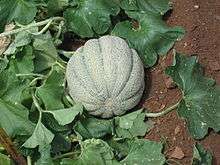 | |
| Scientific classification | |
| Kingdom: | Plantae |
| (unranked): | Angiosperms |
| (unranked): | Eudicots |
| (unranked): | Rosids |
| Order: | Cucurbitales |
| Family: | Cucurbitaceae |
| Genus: | Cucumis |
| Species: | C. melo |
| Binomial name | |
| Cucumis melo L. | |
| Synonyms[1] | |
|
List
| |
Muskmelon (Cucumis melo) is a species of melon that has been developed into many cultivated varieties. These include smooth-skinned varieties such as honeydew, Crenshaw, and casaba, and different netted cultivars (cantaloupe, Persian melon, and Santa Claus or Christmas melon). The Armenian cucumber is also a variety of muskmelon, but its shape, taste, and culinary uses more closely resemble those of a cucumber. The large number of cultivars in this species approaches that found in wild cabbage, though morphological variation is not as extensive. It is a fruit of a type called pepo.
Muskmelon is native to Iran, Anatolia and the Caucasus, with a secondary center including northwest India and Afghanistan.
Genetics
| NCBI genome ID | 10697 |
|---|---|
| Ploidy | diploid |
| Genome size | 374.77 Mb |
| Number of chromosomes | 12 |
| Year of completion | 2012 |
Muskmelons are monoecious plants. They do not cross with watermelon, cucumber, pumpkin, or squash, but varieties within the species intercross frequently.[2] The genome of Cucumis melo L. was first sequenced in 2012.[3]
Nutrition
Per 100 gram serving, cantaloupe melons provide 34 calories and are a rich source (20% or more the Daily Value, DV) of vitamin A (68% DV) and vitamin C (61% DV), with other nutrients at a negligible level.[4] Melons are 90% water and 9% carbohydrates, with less than 1% each of protein and fat.[4]
Uses
In addition to their consumption when fresh, melons are sometimes dried. Other varieties are cooked, or grown for their seeds, which are processed to produce melon oil. Still other varieties are grown only for their pleasant fragrance.[5] The Japanese liqueur, Midori, is flavored with muskmelon.
Gallery
.jpg)
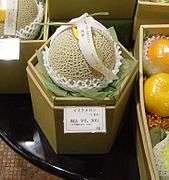
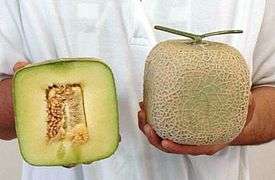 'Squared melon' grown in Atsumi District, Aichi Japan, known as kakumero
'Squared melon' grown in Atsumi District, Aichi Japan, known as kakumero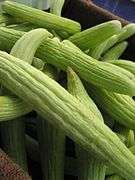 The Armenian cucumber, despite the name, is actually a type of muskmelon.
The Armenian cucumber, despite the name, is actually a type of muskmelon.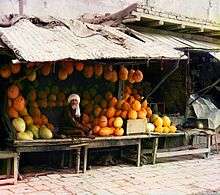 Melon vendor in Samarkand (between 1905 and 1915)
Melon vendor in Samarkand (between 1905 and 1915)- Oriental pickling melon
See also
References
- ↑ The Plant List: A Working List of All Plant Species, retrieved 23 January 2016
- ↑ Martin Anderson, Texas AgriLife Extension Service. "Muskmelons Originated in Persia - Archives - Aggie Horticulture". tamu.edu.
- ↑ Jordi Garcia-Mas. "The genome of melon (Cucumis melo L.)". Proceedings of the National Academy of Sciences. 109: 11872–11877. doi:10.1073/pnas.1205415109.
- 1 2 "Nutrition Facts for 100 g of melons, cantaloupe, raw [includes USDA commodity food A415]". Conde Nast for the USDA National Nutrient Database, version SR-21. 2014.
- ↑ National Research Council (2008-01-25). "Melon". Lost Crops of Africa: Volume III: Fruits. Lost Crops of Africa. 3. National Academies Press. ISBN 978-0-309-10596-5. Retrieved 2008-07-17.
External links
| Wikimedia Commons has media related to: |
- Cucumis melo L. – Purdue University, Center for New Crops & Plant Products.
- Sorting Cucumis names – Multilingual multiscript plant name database
- Cook's Thesaurus: Melons – Varietal names and pictures